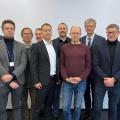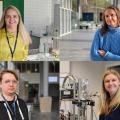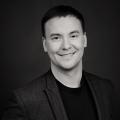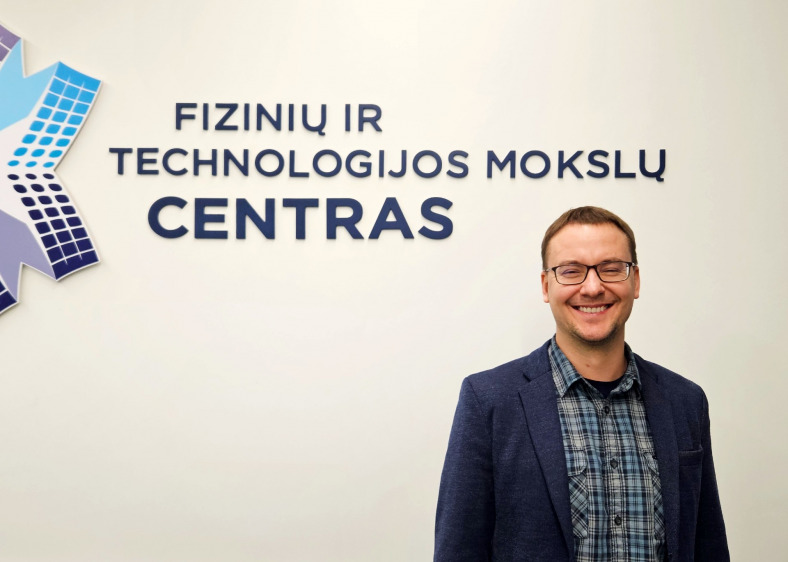News & Events
- Home
- News & Events
- News
News
2023. 12. 20
-
T. Paulauskas, the head of the Lithuanian Quantum Technologies Association: we want to create devices that help each one of us
Almost a month ago, on 22 November, the Lithuanian Quantum Technologies Association (Lietuvos kvantinių technologijų asociacija, LKTA) was established. It brings together three organisations - Vilnius University (Faculty of Mathematics and Informatics together with the Faculty of Physics), Center of Physical Sciences and Technology (FTMC) and the information technology company Novian Technologies.
What are the main goals of LKTA and what technological breakthroughs can we expect from the Lithuanians? Dr. Tadas Paulauskas, head of the association and a researcher at the Department of Optoelectronics of FTMC, tells us about it.
What prompted the establishment of LKTA? Are there already a number of quantum technology developers in Lithuania, so that it is already possible to form an association - or is it more of an aspiration, a goal, to have more such developers?
Probably both. We already have scientists working on quantum technologies. There are some really strong and well-known theoreticians from Vilnius University (VU), and one of the members of LKTA Board, Dr. Mantas Šimėnas from the Faculty of Physics at VU, is involved in technological development. There is also a growing group of VU mathematicians and computer scientists who, together with foreign colleagues, are developing quantum algorithms and testing them on quantum computers.
It is worth noting that it is not only the scientific community that is interested in quantum technologies. Businesses are actively interested in this field and in ways to offer relevant solutions. Collaboration with business is important in order to find solutions for how technologies developed in laboratories can be transformed into products and reach society.
At FTMC, quantum systems of particular relevance to technology have been the subject of theoretical research (and considerable collaboration with experimentalists) by the research group of the physicist Dr. Audrius Alkauskas, who passed away this year. It is now led and continued by a very talented scientist, Dr. Lukas Razinkovas.
At the same time, researchers from the Department of Laser Technologies of FTMC – Dr. Julijanas Želudavičius, Dr. Gediminas Račiukaitis and others - are entering the field of quantum communications. They have recently completed a European Space Agency project to develop entangled photon sources. I believe that in the future we will see a broader entry of this Department into this field and successful technological development.

(The Board of the Lithuanian Quantum Technologies Association. Photo: LKTA)
My own connection with quantum technologies goes back to my PhD, to a course on quantum algorithms. I think I have been looking for the right time to dive headfirst into this field ever since. I started to get more serious about quantum technologies when, during the COVID-19 pandemic, physicist Julius Ruseckas and I published the e-book "Kvantinė kompiuterija" (Quantum Computing). Based on study notes and key literature, this book brings together theoretical knowledge relevant to readers interested in computing as well as in quantum sensors and communications.
After completing the research and experimental development project that I had been working on at FTMC for a few years after my return to Lithuania, I immediately turned to quantum technologies. I have gained a lot of experience in materials science and the technological development of optoelectronic devices, which is very relevant today. I would like to emphasize that our research starts from the very beginning with the study of changes in atomic structures and the resulting new properties of materials.
I am now joined by Dr. Julius Janušonis, an experienced experimental physics researcher and undergraduate student. We study atomic defects in crystals, which can behave like good qubits - units of quantum information. Their main application is for quantum sensors, which we are currently developing. We have built a measurement device, setup that allows us to optically detect the strength and direction of a magnetic field by magnetic resonance.
We are not focusing on fundamental things, but trying to develop specific devices. Basically, we are using materials on which quantum sensors can operate at room temperature. Most quantum systems 'like' extreme conditions, such as very low temperatures, whereas we can do our work in room conditions. This capability allows for a broader application of the technology - more chances of what we do becoming usable products.
What are the useful materials that you are studying at FTMC?
Diamonds contain defects consisting of a nitrogen atom replacing a carbon atom and a vacancy (the empty space where the carbon atom was) attached to it. The spin states of these defects can be controlled, read and initiated. These are extremely stable structures, and crystals as small as a few hundred micrometres or nanometres may be sufficient for applications. Another similar material is silicon carbide.
So we are characterising these and other materials, using ion implantation, laser machining and other techniques to create the desired defects, and we are looking for funding to develop this further. And we are playing with ideas on how to do it.
We have various contributions from other interested researchers and collaborations with groups from both FTMC and VU. We will continue to seek opportunities for collaboration and common interests with other groups and institutions in Lithuania.

(Photo: FTMC)
Where could the quantum sensors you mentioned be used, and in what areas?
At the moment, one of the key applications is magnetic field detection. However, some sensors can also detect ambient temperature, pressure or electric field in parallel. How important is this? The sensors we are focusing on are superior to classical sensors in several aspects. First of all, they can detect lower static or varying magnetic field strengths, and they can operate under extreme conditions (e.g. extremely high temperatures).
In addition, since the sensors are atomic level defects, this opens up the possibility of detecting magnetic fields with atomic spatial resolution. Whether using single defects or many densely arranged in a crystal, the applications are broad.
Using the magnetic field, we can study the properties of semiconductor chips because the electric current flowing in them generates a magnetic field. Quantum sensors based on diamond and silicon carbide are biocompatible. Thus, in single cells or tissues, nanoparticles of these materials become tiny devices that allow the study of biological processes or help to identify markers of disease.
What other applications are possible? For example, to avoid having to lie down in a huge MRI machine, a patient could wear a helmet with many quantum sensor chips. This would allow non-invasive and much more convenient monitoring of spatial neural activity, which is likely to be useful both in biomedicine and in the development of brain-computer interfaces.
Quantum sensors would also be suitable for communication. GPS signals are sometimes not working or are specifically blocked, so local magnetic field maps and the sensors that read them could help autonomous machines to identify their location.
Which area do you think has the most potential for quantum technologies in Lithuania? What can be effective and marketable in the near future?
That is a million-dollar question (smiles). Answering it is one of the tasks of our Association. We have to make a critical assessment of the situation in a consistent way. We are not the only three organisations on the board of LKTA - there are other people, scientific institutions and advanced technology companies in Lithuania that are closely related to quantum technologies but have not yet entered this field. We can encourage this; I think it would not be difficult for them to contribute, to reorient themselves and to do good work with a better understanding of the perspectives.
As far as Lithuania is concerned, we hear about the laser industry, photonics, where Lithuanians are strong. And these areas are particularly relevant to the development of quantum technologies. It is possible to move from photonics research to the development of quantum communications, to the development of various materials or even to the production of components for quantum computers.
I am not talking about the production of the computers themselves in Lithuania, which requires an enormous amount of resources. However, quantum computing is a very broad field, which consists of many things. At the moment, the world is focusing on the development of modular processors, which requires various solutions in the fields of photonics and semiconductors. The production of chips or high-quality optical elements is becoming an issue. So it is worthwhile for us to look at this from a technological point of view.

(Photo: Unsplash.com)
What are your responsibilities as the head of the Lithuanian Quantum Technologies Association?
To see the big picture of where the Association is heading. To monitor whether the goals we have set are being met. Also to make sure that LKTA grows and attracts new members.
I will be looking for solutions to develop the ecosystem of quantum technologies in Lithuania, and will be looking for additional funding to promote our field - to make the public more aware of quantum technologies, to get as many young people involved as possible through events, seminars or hackathons.
In addition, I am in charge of the administrative part: that is, the planning of the various expenses, the reports, etc. - the things that scientists love the most (smiles).
When the announcement about LKTA appeared in the media, together with a picture of the board members, Internet commentators immediately noticed that for some reason there are no women in the Association...
Yes, it's true (smiles). This is bad, and we see it too. Unfortunately, this partly reflects the current situation, if we are talking specifically about scientists who work with quantum technologies. Our community itself is not very large, and there are even fewer women.
One of the tasks of the association will be to correct this situation, to attract women to the board of LKTA, so that we do not create the image that this is a men's issue only. I would like to mention that there are women who have contributed to the creation of the association and are now actively involved in its activities - for example, Dr. Mažena Mackoit-Sinkevičienė, a physicist at FTMC. Female representatives of the Research Council of Lithuania were also involved in the creation process.
In general, the number of women physicists is a problematic topic. Perhaps there is still an image that it is not feminine to be a female physicist, but I think that the situation is gradually improving. In some cases, Lithuania may even be better than other countries. But yes, we would like to see more women in this field.
Interviewed by Simonas Bendžius
Related news:

2023. 11. 24
-
The Lithuanian Quantum Technologies Association is established
Dr. Tadas Paulauskas, a physicist at FTMC, became the head of the Association.

2023. 11. 15
-
From cancer treatment to faster internet: quantum dots aimed to be used by Lithuanian scientists
This Nobel Prize-winning technology has high expectations in both chemistry and physics.

2023. 04. 07
-
Dr. T. Paulauskas: we must move forward with quantum technologies
That was the key message delivered on 30 March in Brussels at the Northern Prospects of Quantum international event.

